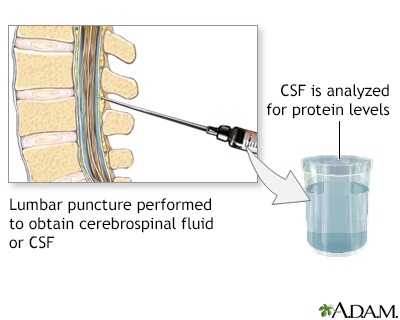Pregnancy SmartSiteTM
DefinitionCSF total protein is a test to determine the amount of protein in cerebrospinal fluid (CSF). CSF is a clear fluid that is in the space around the spinal cord and brain. How the Test is PerformedA sample of CSF is needed [1 to 5 milliliters (ml)]. A lumbar puncture (spinal tap) is the most common way to collect this sample. Rarely, other methods are used for collecting CSF such as:
After the sample is taken, it is sent to a lab for evaluation. Why the Test is PerformedYou may have this test to help diagnose:
Normal ResultsThe normal protein range varies from lab to lab, but is typically 15 to 60 milligrams per deciliter (mg/dL) or 0.15 to 0.6 milligrams per milliliter (mg/mL). Normal value ranges may vary slightly among different laboratories. Talk to your health care provider about the meaning of your specific test results. The examples above show the common measurements for results for these tests. Some laboratories use different measurements or may test different specimens. What Abnormal Results MeanAn abnormal protein level in the CSF suggests a problem in the central nervous system. Increased protein level may be a sign of a tumor, bleeding, nerve inflammation, or injury. A blockage in the flow of spinal fluid can cause the rapid buildup of protein in the lower spinal area. A decrease in protein level can mean your body is rapidly producing spinal fluid or you have a more generalized protein deficiency. ReferencesDeluca GC, Griggs RC. Approach to the patient with neurologic disease. In: Goldman L, Schafer AI, eds. Goldman-Cecil Medicine. 26th ed. Philadelphia, PA: Elsevier; 2020:chap 368. Euerle BD. Spinal puncture and cerebrospinal fluid examination. In: Roberts JR, Custalow CB, Thomsen TW, eds. Roberts and Hedges' Clinical Procedures in Emergency Medicine and Acute Care. 7th ed. Philadelphia, PA: Elsevier; 2019:chap 60. Rosenberg GA. Brain edema and disorders of cerebrospinal fluid circulation. In: Jankovic J, Mazziotta JC, Pomeroy SL, Newman NJ, eds. Bradley and Daroff's Neurology in Clinical Practice. 8th ed. Philadelphia, PA: Elsevier; 2022:chap 88. | |
| |
Review Date: 4/29/2023 Reviewed By: Joseph V. Campellone, MD, Department of Neurology, Cooper Medical School of Rowan University, Camden, NJ. Review provided by VeriMed Healthcare Network. Also reviewed by David C. Dugdale, MD, Medical Director, Brenda Conaway, Editorial Director, and the A.D.A.M. Editorial team. The information provided herein should not be used during any medical emergency or for the diagnosis or treatment of any medical condition. A licensed medical professional should be consulted for diagnosis and treatment of any and all medical conditions. Links to other sites are provided for information only -- they do not constitute endorsements of those other sites. No warranty of any kind, either expressed or implied, is made as to the accuracy, reliability, timeliness, or correctness of any translations made by a third-party service of the information provided herein into any other language. © 1997- A.D.A.M., a business unit of Ebix, Inc. Any duplication or distribution of the information contained herein is strictly prohibited. | |

 CSF protein test
CSF protein test
